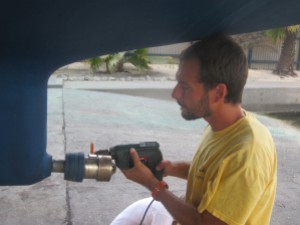Welcome to a potentially endless post. Relax, I’m too busy for a long writing so I’ll try to condensate the experience of checking and preparing a just bought boat for a delivery trip from Caribbean to Europe.
By the way the problem is that the new owner of Eclipse, a lovely Beneteau Idylle 15.50 (German Frers’ design), want to go to Cagliari and even worst that I accepted to go with him. So now we’re busy with a general survey of the yacht, because for both is unknown. Ok, but what would you check on a sailing yacht to know if is ready to an ocean crossing?
 The first suggestion I can give is the following: if you decide to buy a boat in a place but you wanto to sail her somewhere else consider to have a minimum of one month in a botayard to be sure you can fix most of the problems and buy all that you need for a long sailing. Inspecting a boat requires time, patience and several trials, expecially when the past owner disappears after the sale as usually does. Not all boat owners are good sailors so they could not be able to answer to all of your questions.
The first suggestion I can give is the following: if you decide to buy a boat in a place but you wanto to sail her somewhere else consider to have a minimum of one month in a botayard to be sure you can fix most of the problems and buy all that you need for a long sailing. Inspecting a boat requires time, patience and several trials, expecially when the past owner disappears after the sale as usually does. Not all boat owners are good sailors so they could not be able to answer to all of your questions.
Safety is probably the most important matter for life at sea and it begins with a reliable and strong boat. Be sure the rigging, mast, hull and seacocks, bulkheads, sails and ropes, engine and electrical systems are in perfect conditions. There’s no point to go out with a liferaft, EPIRB and all the rescue stuff if the boat has some structural problems.
Another thing to test is that everything on deck is waterproof. Hatches, portholes, deck’s core, fittings and plates, each single hole thru the deck has to be completely sealed. Sailing when down below is wet is terrible especially for long time. Water coming from the sky or the sea has to drain off the deck and not inside. Be sure you can dry the bilge with both electrical and manual devices (bilge pumps, electrical and manual, bucket and sponge, everything) and all the electrical system and electronics stay dry. A dry cockpit is a plus that would make you enjoy even bad weather but the minimum of a safe and dry interior is required. Have almost one head full woking (both toilet and shower) and don’t forget the quality of your sailing often comes from the galley, so make it work!
The equipment has to be adeguate for a month of autonomy at sea. That means enough power in the batteries and adeguate charge system (solar, wind and engine, plus charge contoller). A Watermaker is really helpful but in our case we are considering some traditional remedies as collecting rain, cooking with sea water offshore and storing lots of drinkable water in addition to our generous water tanks.
All the sails and ropes (plus shackles, jammers, blocks) have to be checked. Even if we’re not really sophisticated we changed 70% of the ropes and hardware on board, just for safety. Another important thing is to have few day sailing with the boat and then come back to fix the things that are not working. It’s better to customize everything is possible according to your needs and ability as people sail the same boat in different ways.
Paranoia is the master you’ll follow when preparing a transatlantic crossing, and helps you to keep the attention high about spare parts (carry almost everything!), safety gear and devices, and tools to make emergency fixes on board (a generator should help you with 220v). It will also keep you aware of weather conditions so try to equip the boat with the necessary communication devices to get your forecast (SSB radio, Sat phone, Internet/fax connection). Be sure you have everything and know how to prepare the boat for storm conditions (storm sails, drogues)
But don’t let paranoia absorb you completely or you’ll forget that sailing is for fun and crossing the ocean without pleasure is boring and sad. Try to provision the galley with the best food and drinks (fish cooked on a BBQ is defintely the best!), carry some fishing gears, good books or movies for your time off. A nice coffee and breakfast in the morning or a hot and tasty meal in cold and wet weather keeps the moral of the crew at the right point. Consider cooking as an important part of seamanship.
That’s probably the 12% of what you need to know about this subject, but I have to go back to my work and really don’t have all the answers. I posted these questions on LinkedIn groups and received a huge quantity of answers that helped me to write this partial guide. My thanks go to all the users that replied to my post helping me to have a better frame about what I’m doing to check this lovely boat. One week of last details and if nothing unexpected happens we’ll be heading north to Dominican Republic an then up in the Atlantic, destination Azores and Europe. Go Eclipse!









